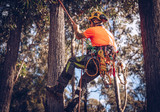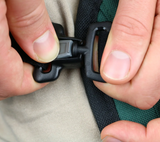What is a line trimmer, or as Kiwis call it, the weed eater?
If you have spent more than a day in landscaping or grounds maintenance in New Zealand, you already know the line trimmer, or weed eater as most of us call it, is a must-have tool. It reaches the tricky corners the mower misses, cleans up fence lines, and makes edges look sharp. But for all its usefulness, it is also one of the biggest hazards on site.
Every time the nylon cord spins, anything in its way can become a high-speed projectile. It might be a hidden stone, a rusty nail, or a bit of glass. At shin height, those hits hurt. They do not just sting. They can bruise, cut, and in some cases, send you to A&E. That is why more Kiwi landscapers, from Northland to Southland, are turning to Clogger New Zealand’s Line Trimmer (Weed Eater) Gaiters as essential PPE.
What are line trimmer (weed eater) gaiters?
Line trimmer gaiters are protective covers you wear over your boots and pants. They sit across your shins, calves, and ankles, acting as a barrier between your legs and the flying debris your weed eater sends out. Unlike jeans or heavy trousers, gaiters are purpose-built. They combine toughness with breathability, meaning you can work through a hot Gisborne summer or a wet Invercargill winter without overheating or soaking your gear.
Clogger New Zealand has developed gaiters that balance both safety and comfort. Their design makes them easy to strap on before a job and reliable enough to take hit after hit without wearing out quickly.
Why are gaiters so important in New Zealand?
Many Kiwis still think of gaiters as something you wear when hunting or tramping in the bush. But in reality, leg protection is one of the most overlooked safety measures in landscaping.
WorkSafe New Zealand has reported that flying debris from groundskeeping equipment is a common cause of workplace injury. The problem with weed eaters is that most of the debris is thrown low, right where your legs are. While we all pay attention to eye and ear protection, shins and ankles often take the biggest beating.
Clogger New Zealand recognised this gap in PPE and built gaiters specifically to meet the needs of Kiwi landscapers.
How do the seasons affect the risks?
Landscaping in New Zealand is never the same from January to July. The hazards shift with the seasons.
Summer – Dry, hard ground and loose stones
In regions like Central Otago, Canterbury, and Hawke’s Bay, the ground bakes hard and stones loosen on the surface. Hit one with a trimmer line and it becomes a missile. Urban crews deal with gravel from driveways or clumps of dried dirt that hide glass or metal shards.
Autumn – Leaf cover and hidden surprises
The fallen leaves are beautiful, but they mask hazards. Sticks, fence bolts, and even drink cans can sit unseen until your trimmer hits them. In windy areas like Wellington and Wairarapa, debris from neighbouring properties often adds to the risk.
Winter – Wet, muddy, and slippery
In the South Island especially, the cold brings damp ground, moss on paths, and frozen soil. Wet debris can flick out at speed, and even a small stone hitting your shin on frozen ground hurts more than you expect.
Spring – Rapid growth, hidden hazards
Grass and weeds shoot up fast in spring. Sprinkler heads, wires, or pieces of timber are often hidden until your trimmer catches them. On farms and orchards, pruned branches and repair scraps often get buried under growth, waiting for the line to find them.
Do different regions in NZ face different problems?
Yes. Each region brings its own challenges:
-
Northland and Auckland – Subtropical growth that hides debris, sandy soils near the coast, and sharp shell fragments in reserves.
-
Waikato and Bay of Plenty – Volcanic soils that break into sharp fragments, plus heavy grass growth in humidity.
-
Wellington and Lower North Island – High winds scatter loose debris, stones, and metal fragments into trimming zones.
-
Canterbury and Otago – Dry gravel in summer, frozen hard debris in winter.
-
Southland – Constant damp ground, sticks hidden in thick grass, and mud that hides hazards.
Clogger New Zealand designs its gaiters with these exact conditions in mind.
Why do Kiwi landscapers choose Clogger gaiters?
Clogger is proudly New Zealand-made, which means every feature in their Line Trimmer (Weed Eater) Gaiters is informed by local worksite challenges.
-
A tough outer shell that deflects stones, sticks, and metal fragments.
-
Lightweight, breathable fabric so you can wear them through hot summers.
-
Quick-fit adjustable straps that fit over work boots or gumboots.
-
Long-lasting durability, built to survive season after season of tough use.
Do landscapers actually wear them all day?
One of the biggest problems with PPE is comfort. If gear is heavy or restrictive, workers leave it in the ute. Clogger New Zealand solved this by designing gaiters that are light, flexible, and easy to put on. Landscapers often say they forget they are even wearing them until a stone bounces off instead of hitting bare skin.
Is it just about rocks and sticks?
Not in New Zealand. While we do not have venomous snakes, the trimming zone is full of surprises. Hedgehogs, wētā, wasps, and even bits of rubbish can make life difficult. Gaiters offer an extra layer of confidence when you are working in long grass or overgrown reserves.
How do you care for gaiters?
Looking after them is simple:
-
Brush or rinse off dirt and mud after use.
-
Let them dry completely before storing.
-
Check straps and buckles for a snug fit.
-
Store them with the rest of your PPE to keep them ready.

Why Kiwi landscapers swear by them
From summer’s baked ground to winter’s soggy lawns, the risks in New Zealand change with the seasons. One thing does not change: flying debris always finds your legs. That is why more crews are adding gaiters to their essential PPE.
Clogger New Zealand’s Line Trimmer (Weed Eater) Gaiters are light, tough, and designed right here for Kiwi worksites. They keep shins safe, jobs moving, and injuries out of the picture.




